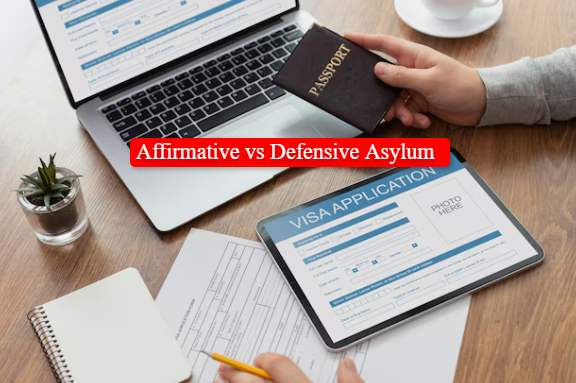The Difference Between Affirmative And Defensive Asylum
At Passage Immigration Law, we’ve sat with people at every stage of the asylum process, from the nervous first meeting where someone pulls out a worn folder of documents, to the moment they breathe out in relief because their case has been approved.
If you’ve been searching for answers about the affirmative asylum process or the defensive asylum process, we want you to hear it from us: these aren’t just legal terms. There are two different ways of asking the U.S. for protection when you can’t safely return home. The law is the same, but the way you get there and what the journey feels like can be very different.
Affirmative Asylum: You are not currently in Removal Proceedings
When we work with someone on an affirmative asylum case, it means they’re not in immigration court yet. Maybe you came here on a visa, maybe you crossed the border and haven’t been placed in removal proceedings; either way, you still have the option to go directly to USCIS.
Here’s how we guide our clients through it:
- We prepare and file Form I-589 — your application for asylum in the USA.
- We help you through biometrics — fingerprints, photos, and background checks.
- We prepare you for your interview — what to expect, what questions you’ll hear, and how to handle follow-ups.
- We attend your affirmative asylum interview with you — this isn’t a trial, it’s a conversation with an asylum officer in an office.
If you win, you’re granted asylum. If you don’t, and you don’t have another legal status, your case gets referred to immigration court, and that’s when it becomes defensive.
About the wait: The affirmative asylum interview wait time depends on where you live and USCIS priorities. Sometimes new cases get scheduled quickly under “Last In, First Out.” Other times, the backlog is years long. We keep our clients updated and ready for an interview at short notice.
Defensive Asylum: Fighting Your Case In Court
When we take on a defensive asylum case, it’s because you’re already in removal proceedings.
Maybe you were stopped at the border, overstayed your visa, or got referred from an affirmative case.
Here’s what that looks like with us by your side:
- We file Form I-589 with the court and make sure DHS counsel receives it.
- We appear with you at your Master Calendar Hearing to set your schedule.
- We prepare for your Individual (Merits) Hearing like it’s the most important day of your life because it is.
- In court, we present your testimony, your witnesses, and your evidence. The DHS attorney will challenge your case, and we’ll be ready for that cross-examination.
This is why it’s called the defensive asylum process; we’re literally defending you against deportation in front of a judge.
How We Explain The Difference To Our Clients

- Affirmative: You’re not in court. You meet an asylum officer in an office.
- Defensive: You’re in immigration court, with a government attorney questioning you.
The same protection, two very different processes.
How Long Will It Take?
We’re honest with our clients: the asylum processing time in the USA is unpredictable.
- Affirmative asylum processing times depend on your asylum office’s backlog. We track this closely and keep you posted.
- Defensive asylum cases depend on the immigration court calendar, and with current backlogs, it can take years to reach your hearing.
What We Help You Prove
No matter which path you’re on, affirmative asylum vs defensive asylum, we build your case to show:
- You’ve faced persecution, or have a well-founded fear of it.
- It’s because of your race, religion, nationality, political opinion, or membership in a particular social group.
We help you:
- Write a clear, consistent personal statement.
- Gather supporting documents from letters to official reports.
- Match your story with country conditions evidence so the officer or judge sees the bigger picture.
Types Of Asylum In The U.S.
When clients ask about asylum types in the US, we explain:
- Asylum: The main protection is a green card after one year with family reunification options.
- Withholding of Removal: Higher burden of proof, no green card, but blocks deportation.
- CAT (Convention Against Torture): Stops removal if torture is likely, but no green card.
The difference between affirmative asylum and defensive asylum isn’t about the type; it’s about the process.
Mistakes We Make Sure You Don’t Make

We’ve seen how easy it is to lose time or weaken a case. We protect you from:
- Filing late without a valid exception.
- Inconsistent details that hurt credibility.
- Unorganized, untranslated evidence.
- Walking into court unprepared for cross-exam.
- Missing new rules like the 2025 filing fee changes ($100 to file I-589, plus $100 annually while pending).
Which Country Gives Asylum Easily?
We get asked this all the time. Our answer? There’s no “easy” country. Winning asylum in the United States comes down to preparation, consistency, and credible evidence, not luck or shortcuts.
Why The Right Preparation Changes Everything
We’ve seen it over and over: strong preparation turns nervous, uncertain clients into people who can walk into an interview or hearing and speak their truth with clarity.
That’s why, whether you’re on the affirmative asylum or defensive asylum path, we:
- Map out your timeline from memory and documents.
- Fill in the gaps before the government points them out.
- Anticipate the hard questions so they don’t catch you off guard.
You’ll never hear us say, “Just tell your story and you’ll be fine.”
We believe in telling your story the right way so the officer or judge understands it, remembers it, and believes it.
How We Stand With You
When you work with us at Passage Immigration Law:
- We explain the application for asylum in the USA step-by-step.
- We prepare you for every question you might hear.
- We fight for you in court, if it comes to that.
- We keep you informed about your asylum cases, USA status, timelines, and next steps.
You’re not just hiring lawyers, you’re gaining a team that sees you as a person, not a file number.
Ready To Talk About Your Asylum Case?

If you’re unsure whether you need the affirmative asylum process or the defensive asylum process, we can help you figure it out today.
At Passage Immigration Law, we guide people through every step: interviews, hearings, evidence gathering, and appeals. Whether you’re just starting or already in court, we’ll stand with you from the first form to the final decision.
Disclaimer: This article offers general legal information, not legal advice. Do not rely upon this information without seeking legal counsel. If you need legal advice, you may contact us directly to speak with an attorney. We disclaim all liability with respect to actions taken based on any information presented. Every case is different, and outcomes will vary depending on the unique facts and legal issues of your case.







